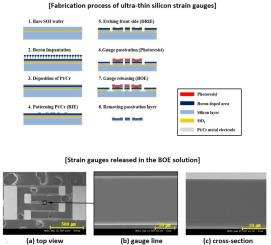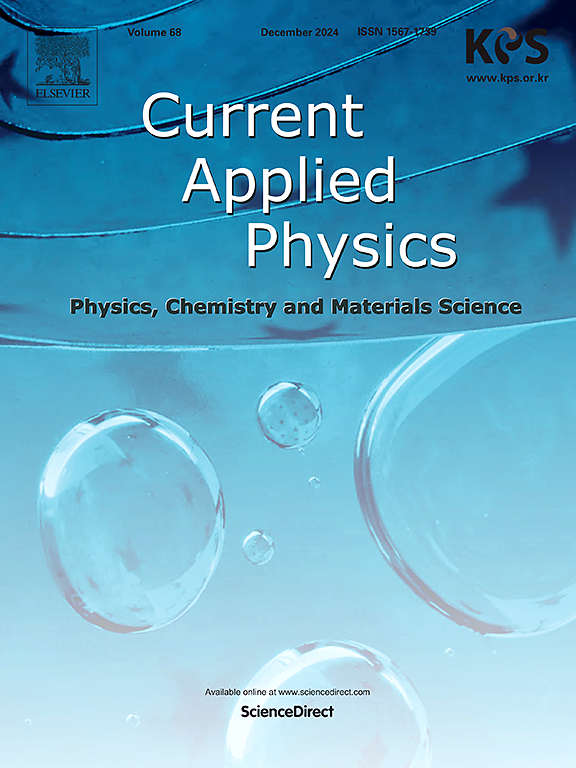设计和制造用于压阻压力传感器的超薄硅基应变片
IF 2.4
4区 物理与天体物理
Q3 MATERIALS SCIENCE, MULTIDISCIPLINARY
引用次数: 0
摘要
采用新构思的湿法蚀刻工艺,在硅绝缘体(SOI)晶片上制作了超薄(20 微米)硅应变片。湿法蚀刻工艺采用了添加辛胺和辛醇的缓冲氧化物蚀刻剂(BOE,NH4F:HF = 6:1)溶液,工作温度为 50°C。光刻胶作为钝化层沉积在 SOI 晶圆的上侧,以减少化学蚀刻剂对应变计的损坏。在 BOE 溶液中加入少量辛胺和辛醇,以改善表面润湿性和二氧化硅/硅的选择性。将制作好的应变片连接到压力膜片上,利用液压系统测量应变片的性能。电阻随拉伸和压缩应变呈线性变化。非线性、滞后、热阻系数(TCR)和灵敏度的最大值分别为-0.341 %、0.909 %、4128 ppm/°C 和 34.22 mV/V。所制作的应变片可很好地应用于氢气压力传感器,在高压范围(0-900 巴)内均可检测。本文章由计算机程序翻译,如有差异,请以英文原文为准。

Design and fabrication of ultrathin silicon-based strain gauges for piezoresistive pressure sensor
Ultra-thin (20 μm) silicon strain gauges were fabricated with silicon-on-insulator (SOI) wafer by a newly-conceived wet etching process. Buffered oxide etchant (BOE, NH4F: HF = 6:1) solution with additives of octylamine and octanol was used for wet etching process in which the operating temperature was 50°C. Photoresist as a passivation layer was deposited on the upper side of SOI wafer to minimize strain gauge damage by chemical etchants. Small amount of octylamine and octanol were added to BOE solution to improve surface wettability and SiO2/Si selectivity. The fabricated strain gauges were attached to the pressure diaphragm and the performance of strain gauge was investigated by measuring with the hydraulic pressure system. The resistance changed linearly with tensile and compressive strains. Maximum values of non-linearity, hysteresis, thermal coefficient of resistance (TCR) and sensitivity were -0.341 %, 0.909 %, 4128 ppm/°C and 34.22 mV/V respectively. The fabricated strain gauges might be well applicable to the hydrogen pressure sensor which is detectable for high pressure range (0–900 bar).
求助全文
通过发布文献求助,成功后即可免费获取论文全文。
去求助
来源期刊

Current Applied Physics
物理-材料科学:综合
CiteScore
4.80
自引率
0.00%
发文量
213
审稿时长
33 days
期刊介绍:
Current Applied Physics (Curr. Appl. Phys.) is a monthly published international journal covering all the fields of applied science investigating the physics of the advanced materials for future applications.
Other areas covered: Experimental and theoretical aspects of advanced materials and devices dealing with synthesis or structural chemistry, physical and electronic properties, photonics, engineering applications, and uniquely pertinent measurement or analytical techniques.
Current Applied Physics, published since 2001, covers physics, chemistry and materials science, including bio-materials, with their engineering aspects. It is a truly interdisciplinary journal opening a forum for scientists of all related fields, a unique point of the journal discriminating it from other worldwide and/or Pacific Rim applied physics journals.
Regular research papers, letters and review articles with contents meeting the scope of the journal will be considered for publication after peer review.
The Journal is owned by the Korean Physical Society.
 求助内容:
求助内容: 应助结果提醒方式:
应助结果提醒方式:


